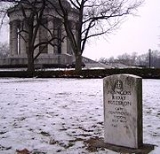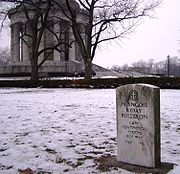
François Riday Busseron
Encyclopedia
François Riday Busseron was a French fur trader, general store operator, and militia captain in the American village of Vincennes
. He supported the Americans during the American Revolution
and funded the first American flag
made in Indiana. As a U.S. citizen, he would serve as a judge in the court of general quarter sessions.
Busseron was born in 1748, when the Northwest Territory
was still part of New France
. The territory became the domain of the British Empire
following the French and Indian War
, but Busseron elected to stay. On hearing the news of the American Revolution and the French alliance from Father Gibault
, however, Busseron declared for the Americans.
 When Lt-Governor Henry Hamilton retook control of Fort Sackville and confiscated local supplies of ammunition, Busseron, along with Colonel Legras, "buried the greater part of their powder and ball." George Rogers Clark
When Lt-Governor Henry Hamilton retook control of Fort Sackville and confiscated local supplies of ammunition, Busseron, along with Colonel Legras, "buried the greater part of their powder and ball." George Rogers Clark
and his American forces arrived on 23 February 1779, his black powder ruined while wading across the Wabash River
. Clark wrote of Legras and Busseron, "We found ourselves well supplied by those gentlemen." Hamilton noted not only that Busseron supplied Clark with powder, but that he also offered the services of himself and 75 men of the Vincennes militia, which greatly discouraged the French inside Fort Sackville.
Busseron was involved in many of the Vincennes militia actions, including a mission led by Captain Leonard Helm
that captured Hamilton's reinforcements on the Wabash River
. When Clark withdrew his Virginia troops in Spring 1780, he left Busseron in charge of the fort- now renamed Fort Patrick Henry.
By 1781, the French residents of Vincennes had become frustrated with the Virginia government, depreciated US currency, and the Virginia militias that used or took their property without proper compensation. The leading citizens of Vincennes, including François Busseron, signed a letter of grievances to the governor of Virginia. Over the course of the American Revolution, Busseron extended up to $12,000 credit to Clark. None of this was ever repaid to him. He and all but one of his children died in poverty.
Busseron died in 1791 at age 43. Joseph Somes says he died "a broken and much disillusioned man." He is buried near the Old French Cathedral in Vincennes, next to the George Rogers Clark National Historic Park
.
Busseron Street, in Vincennes, is named in honor of François Busseron. Busseron Creek and Busseron Township, both in Knox County, Indiana
, are also named for him.
Vincennes, Indiana
Vincennes is a city in and the county seat of Knox County, Indiana, United States. It is located on the Wabash River in the southwestern part of the state. The population was 18,701 at the 2000 census...
. He supported the Americans during the American Revolution
American Revolution
The American Revolution was the political upheaval during the last half of the 18th century in which thirteen colonies in North America joined together to break free from the British Empire, combining to become the United States of America...
and funded the first American flag
George Rogers Clark Flag
The George Rogers Clark Flag is a red and green striped banner in the model of American Flags commonly associated with George Rogers Clark, although Colonel Clark did not campaign under these colors...
made in Indiana. As a U.S. citizen, he would serve as a judge in the court of general quarter sessions.
Busseron was born in 1748, when the Northwest Territory
Northwest Territory
The Territory Northwest of the River Ohio, more commonly known as the Northwest Territory, was an organized incorporated territory of the United States that existed from July 13, 1787, until March 1, 1803, when the southeastern portion of the territory was admitted to the Union as the state of Ohio...
was still part of New France
New France
New France was the area colonized by France in North America during a period beginning with the exploration of the Saint Lawrence River by Jacques Cartier in 1534 and ending with the cession of New France to Spain and Great Britain in 1763...
. The territory became the domain of the British Empire
British Empire
The British Empire comprised the dominions, colonies, protectorates, mandates and other territories ruled or administered by the United Kingdom. It originated with the overseas colonies and trading posts established by England in the late 16th and early 17th centuries. At its height, it was the...
following the French and Indian War
French and Indian War
The French and Indian War is the common American name for the war between Great Britain and France in North America from 1754 to 1763. In 1756, the war erupted into the world-wide conflict known as the Seven Years' War and thus came to be regarded as the North American theater of that war...
, but Busseron elected to stay. On hearing the news of the American Revolution and the French alliance from Father Gibault
Pierre Gibault
Father Pierre Gibault was a Jesuit missionary and priest in the Northwest Territory in the 18th century, and an American Patriot during the American Revolution....
, however, Busseron declared for the Americans.

George Rogers Clark
George Rogers Clark was a soldier from Virginia and the highest ranking American military officer on the northwestern frontier during the American Revolutionary War. He served as leader of the Kentucky militia throughout much of the war...
and his American forces arrived on 23 February 1779, his black powder ruined while wading across the Wabash River
Wabash River
The Wabash River is a river in the Midwestern United States that flows southwest from northwest Ohio near Fort Recovery across northern Indiana to southern Illinois, where it forms the Illinois-Indiana border before draining into the Ohio River, of which it is the largest northern tributary...
. Clark wrote of Legras and Busseron, "We found ourselves well supplied by those gentlemen." Hamilton noted not only that Busseron supplied Clark with powder, but that he also offered the services of himself and 75 men of the Vincennes militia, which greatly discouraged the French inside Fort Sackville.
Busseron was involved in many of the Vincennes militia actions, including a mission led by Captain Leonard Helm
Leonard Helm
Leonard Helm was an early pioneer of Kentucky, and a Virginia officer during the American Revolutionary War. Born around 1720 probably in Fauquier County, Virginia, he died in poverty while fighting Native American allies of British troops during one of the last engagements of the Revolutionary...
that captured Hamilton's reinforcements on the Wabash River
Wabash River
The Wabash River is a river in the Midwestern United States that flows southwest from northwest Ohio near Fort Recovery across northern Indiana to southern Illinois, where it forms the Illinois-Indiana border before draining into the Ohio River, of which it is the largest northern tributary...
. When Clark withdrew his Virginia troops in Spring 1780, he left Busseron in charge of the fort- now renamed Fort Patrick Henry.
By 1781, the French residents of Vincennes had become frustrated with the Virginia government, depreciated US currency, and the Virginia militias that used or took their property without proper compensation. The leading citizens of Vincennes, including François Busseron, signed a letter of grievances to the governor of Virginia. Over the course of the American Revolution, Busseron extended up to $12,000 credit to Clark. None of this was ever repaid to him. He and all but one of his children died in poverty.
Busseron died in 1791 at age 43. Joseph Somes says he died "a broken and much disillusioned man." He is buried near the Old French Cathedral in Vincennes, next to the George Rogers Clark National Historic Park
George Rogers Clark National Historical Park
George Rogers Clark National Historical Park, located in Vincennes on the banks of the Wabash River at what is believed to be the site of Fort Sackville, is a United States National Historical Park. A classical memorial here was authorized under President Calvin Coolidge and dedicated by President...
.
Busseron Street, in Vincennes, is named in honor of François Busseron. Busseron Creek and Busseron Township, both in Knox County, Indiana
Knox County, Indiana
As of the census of 2000, there were 39,256 people, 15,552 households, and 10,139 families residing in the county. The population density was 76 people per square mile . There were 17,305 housing units at an average density of 34 per square mile...
, are also named for him.

